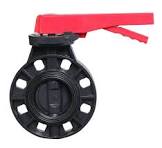
Water treatment and distribution systems require durable, efficient, and low-maintenance components to ensure uninterrupted service. Among the most crucial flow control devices used in such systems are butterfly valves. When it comes to non-corrosive, lightweight, and cost-effective solutions, UPVC butterfly valves stand out as a preferred choice, especially for water plants.
UPVC (Unplasticized Polyvinyl Chloride) butterfly valves are specially designed to withstand the demanding environments of water processing, treatment, and distribution plants. They provide excellent resistance to corrosion, chemicals, and sediment buildup while maintaining high flow efficiency with minimal pressure drop.
What Are UPVC Butterfly Valves?
UPVC butterfly valves are quarter-turn valves that use a circular disc to regulate the flow of fluid through a pipe. The disc rotates around its axis and is either parallel or perpendicular to the flow of water. These valves are known for their quick operation, compact design, and suitability for a wide range of applications in water treatment.
Made from unplasticized PVC material, these valves do not contain any plasticizers, which means they retain structural integrity even under prolonged exposure to chemicals, pressure, and temperature fluctuations. This makes them a preferred choice for water plants where corrosion and chemical exposure are common challenges.
Key Features of UPVC Butterfly Valves for Water Plants
1. Corrosion-Free Operation
One of the most significant benefits of UPVC butterfly valves is their complete resistance to rust and corrosion. In water treatment plants, valves are frequently exposed to chlorinated water, dissolved salts, and other chemicals. UPVC resists degradation from these substances far better than metal valves, ensuring a longer operational life with minimal maintenance.
2. Low Pressure Loss
The internal design of UPVC butterfly valves ensures a streamlined water path with minimal resistance. This results in low pressure loss across the valve, which is essential for maintaining high energy efficiency and consistent flow rates throughout the water distribution network.
3. Lightweight and Easy to Install
Compared to metal valves, UPVC butterfly valves are significantly lighter, making them easier to transport, handle, and install. This feature is particularly beneficial in large-scale water plants where multiple valves are installed across extensive pipeline networks.
4. Excellent Chemical Resistance
UPVC valves can handle various water treatment chemicals, including chlorine, sodium hypochlorite, and coagulants. Their non-reactive material ensures that these chemicals do not corrode or degrade the valve components, thus preventing contamination and extending service life.
5. Low Maintenance Requirements
Due to their non-corrosive and scale-resistant nature, UPVC butterfly valves require little to no maintenance over time. There’s no need for frequent lubrication, painting, or surface treatment, which reduces the total cost of ownership for water utilities.
6. Tight Shut-Off Capability
Modern UPVC butterfly valves are designed with elastomeric seats (typically EPDM or FKM) that provide excellent sealing performance. This helps ensure tight shutoff, preventing leaks and loss of treated water.
7. Manual, Electric, or Pneumatic Operation
UPVC butterfly valves can be operated manually using a lever or gear box, or automatically using electric or pneumatic actuators. This makes them suitable for both simple and complex automated systems in water treatment plants.
Applications in Water Plants
UPVC butterfly valves are used across various stages of the water treatment and supply process. Their durability and resistance to chemicals make them ideal for:
1. Raw Water Intake Systems
These valves control the flow of raw water from natural sources such as rivers or reservoirs into the treatment facility. The corrosion resistance of UPVC ensures that particles and contaminants in the raw water do not degrade the valve.
2. Chemical Dosing and Mixing
Water plants use chemicals for disinfection, coagulation, and pH adjustment. UPVC valves are ideal for handling chemical solutions because of their compatibility with aggressive media.
3. Filtration and Sedimentation Units
Butterfly valves help regulate water flow between filtration beds and sedimentation tanks. Their smooth internal surface prevents scaling and clogging, ensuring smooth water passage.
4. Distribution Networks
In potable water distribution lines, UPVC butterfly valves are used to isolate, regulate, or redirect flow. Their long life span and leak-proof design are critical for ensuring water quality and reducing downtime.
5. Backwash and Cleaning Cycles
UPVC butterfly valves operate efficiently in backwashing processes where flow direction needs to be reversed. Their quick-opening design is especially useful in such time-sensitive cleaning operations.
Material and Design Considerations
UPVC butterfly valves are typically designed with the following material configurations:
-
Body: UPVC (Unplasticized Polyvinyl Chloride)
-
Disc: UPVC, PP (Polypropylene), or PVDF for more aggressive media
-
Seat: EPDM for water applications, FKM (Viton) for chemical resistance
-
Shaft: Stainless steel or coated materials for added strength
-
O-rings & Seals: NBR or EPDM, depending on fluid type
These valves are available in wafer-style (for installation between flanges) or lug-style designs (which can be installed at the end of pipelines or used for dead-end service).
Advantages Over Metal Butterfly Valves
-
Cost-Effective: UPVC valves are generally more affordable than stainless steel or cast iron valves.
-
No Corrosion: Ideal for chlorinated water and chemical-rich environments.
-
Non-Conductive: UPVC provides insulation and is resistant to electrochemical reactions.
-
Fast Installation: Lightweight design means easier and quicker installation with reduced labor.
-
Longer Service Life: Especially in environments with aggressive fluids or salt-laden water.
Choosing the Right Valve for Your Water Plant
When selecting a UPVC butterfly valve for a water plant, consider the following:
-
Pipe size and pressure rating
-
Chemical compatibility with the media
-
Operating temperature
-
Manual vs. automated operation
-
Mounting requirements and space constraints
Always verify that the valve complies with applicable standards such as ISO, DIN, or ASTM for pressure ratings and flange dimensions.
Conclusion
UPVC butterfly valves offer a corrosion-free, lightweight, and highly efficient solution for water treatment and distribution plants. Their ability to handle aggressive chemicals, resist scale buildup, and maintain low pressure loss makes them indispensable in ensuring safe and continuous water flow. With options for manual and automated control, they are suitable for both small municipal systems and large-scale industrial water processing operations.
If you’re seeking a reliable, cost-effective valve with minimal maintenance needs for your water plant, UPVC butterfly valves are an excellent long-term investment.




